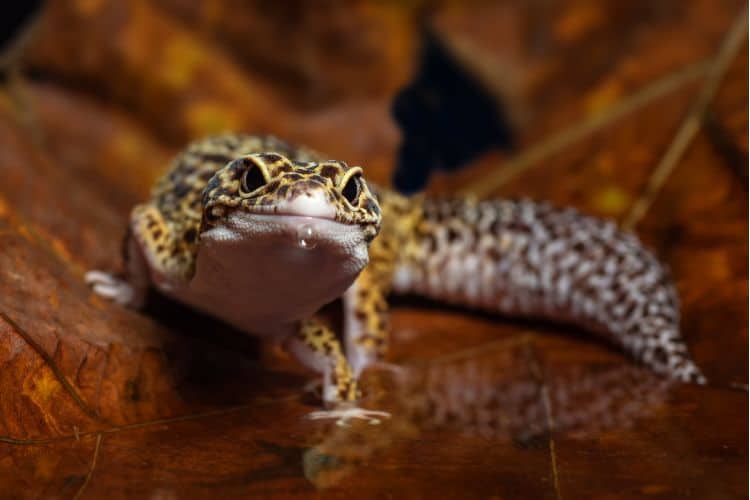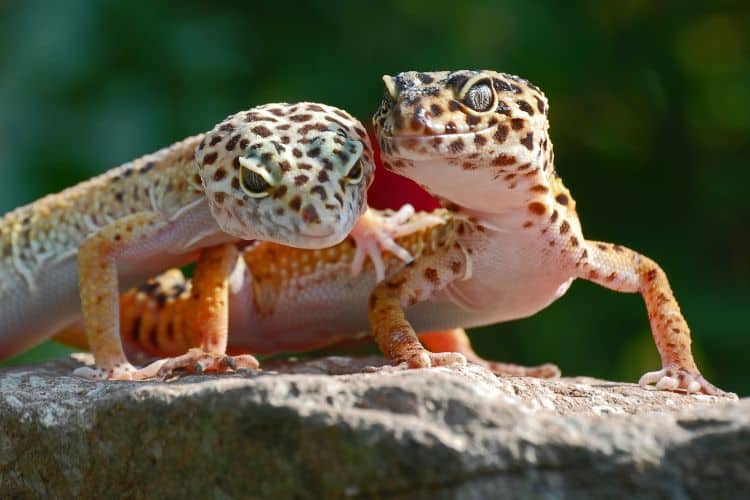Have you ever noticed your leopard gecko wagging its tail back and forth? This peculiar behavior is common in leopard geckos, but what does it mean? From sassy signals to signs of sickness, tail wagging can reveal a lot about how our spotted reptile pals are feeling.
Leopard geckos use their tails for more than just storing fat reserves – they are a key communication tool! Through intricate tail dances, leopard geckos can send messages to each other about everything from their mood to their interest in mating.
Leopard gecko tail wagging is not all fun and games. Sometimes those shimmies are an early indicator of health problems like metabolic bone disease. So while tail wagging can be cute, it’s important to understand what normal vs abnormal wagging looks like.
By learning how to “speak their language,” we can better interpret our pets’ behaviors and keep their tails wagging happily.
Is Leopard Gecko Tail Wagging Normal?
Leopard geckos naturally wag their tails throughout the day. But, excessive, weak, or aimless wagging may signal causes for concern. Healthy leopard geckos will wag in response to specific stimuli, and then stop shortly after.
In general, if your leopard gecko is wagging its tail occasionally and seems otherwise healthy and relaxed, there’s no need to worry.
However, if the tail wagging is accompanied by other troubling signs like lethargy, loss of appetite, or unusual coloration, it’s a good idea to consult your veterinarian.

Reasons for Leopard Gecko Tail Wagging
Understanding your gecko’s communication is key to building a strong bond, and ensuring its well-being. So, observe your pet closely and learn to interpret its unique language!
1. Communication
Leopard geckos will wag their tails as a form of communication with each other. Different speeds and patterns of wagging are thought to convey different messages to other geckos.
2. Defensive Response
Rapid tail wagging while the gecko has its mouth open is often a defensive behavior. This occurs when a leopard gecko feels threatened.
3. Hunting Behavior
Slower, more controlled wagging may indicate a gecko is tracking prey or preparing to pounce. The gecko is likely anticipating food.
4. Excitement/Anticipation
Faster wagging can also be a sign of excitement or anticipating something positive, like feeding time or being handled. This also happens when your pet is showing a desire to mate with female leopard geckos.
5. Stress or Fear
Stressful events like cage cleaning or loud noises may cause fearful tail wagging. This looks similar to defensive wagging.
6. Illness/Health Issues
In some cases, frequent or weak tail wagging may point to health problems like metabolic bone disease, tail rot, or neurological issues.
7. Acknowledgment
Slow side-to-side swaying often indicates the gecko acknowledges another gecko’s presence or accepts your handling.

Different Types of Leopard Gecko Tail Wags and Their Meanings
Leopard geckos are masters of tail communication, using subtle movements to express a wide range of emotions and intentions. Recognizing these wagging signals can significantly improve your understanding of your scaly friend. Here’s a breakdown of the most common types:
| Movement | Meaning | Context | Additional Notes |
| Slow sideways sway | Acknowledgement, contentment, submission | Gecko sees another gecko or familiar human, being handled gently | Can also indicate interest in food or exploring a new area |
| Fast sideways flicks | Excitement, hunting display, warning | Observing prey, competing for a mate, encountering another aggressive gecko | May be accompanied by puffed throat or vocalizations |
| Vibrating/trembling wag | Defensive posture, warning | Feeling threatened by another gecko, being touched in an uncomfortable way | Often precedes biting or tail dropping |
| Tail held high and waved slowly | Territorial display, warning | Protecting territory, competing for mates | More common in males, often accompanied by puffed throat and head bobs |
| Fast jerky flicks | Pain, discomfort | Injured, stressed, being restrained too tightly | Seek veterinary attention if persistent or accompanied by other concerning signs |
| Twitching after dropping tail | Reflexive response | Losing tail as a defense mechanism | Tail will eventually regenerate but requires proper care |
Remember:
- These are just general interpretations, and observing the overall context is crucial. Consider body language, other gecko interactions, and recent events to accurately decipher the message.
- Individual variations exist. Some geckos might express themselves more subtly, while others are more flamboyant. Pay attention to your specific gecko’s unique communication style.
- Tail wags alone might not tell the whole story. Combine them with other cues for a complete picture.
When to Be Concerned About Leopard Gecko Tail Wagging
While some tail wags are perfectly normal for leopard geckos, there are situations where you should be concerned. Here are some red flags to watch out for:
Tail Wagging Frequency and Intensity
- Excessive or constant tail wags: This could indicate stress, discomfort, or fear. Pay attention if the wags are accompanied by other stressed behaviors like pacing, hiding, or loss of appetite.
- Sudden change in tail wagging behavior: If your gecko typically has calm, gentle wags but suddenly starts exhibiting fast, jerky flicks, it might be experiencing pain or discomfort.
Context of the Tail Wagging
- Tail wagging when being handled: While some geckos tolerate handling well, a wagging tail could indicate feeling nervous or stressed. Observe their body language for signs of anxiety like flattened posture or closed eyes.
- Tail wagging around new objects or animals: This is natural territorial behavior, but be concerned if it becomes aggressive, accompanied by hissing or biting.
- Tail wagging after dropping their tail: While normal after autotomy, continuous twitching or excessive bleeding requires veterinary attention.
Additional Signs to Watch For
- Lethargy or decreased activity: This could indicate illness or other health problems.
- Loss of appetite or difficulty eating: This can be a sign of stress, illness, or mouth pain.
- Unusual coloration or skin issues: Discoloration, shedding problems, or skin lesions might indicate underlying health issues.
What to Do if You’re Concerned
- Stop handling your gecko immediately: If your gecko seems stressed or uncomfortable, give them space and time to calm down.
- Remove any potential stressors: This could include new decorations, other animals, or loud noises.
- Monitor their behavior closely: Observe their overall health and activity level for any other concerning signs.
- Consult your veterinarian: If you’re worried about your gecko’s tail wags or any other symptoms, consult a reptile vet for professional diagnosis and treatment.
Conclusion
A wagging leopard gecko tail can communicate different meanings based on the speed, direction, and scenario.
While some wagging is normal communication, excessive or frantic wagging may require examining the gecko’s habitat, diet, handling, and health. With a proper understanding of your leopard gecko’s tail wagging, you can best interpret this interesting behavior!
If you want to know more about your gecko’s behavior, you can check out the answer to why is my leopard gecko glass surfing and are leopard geckos smart.

